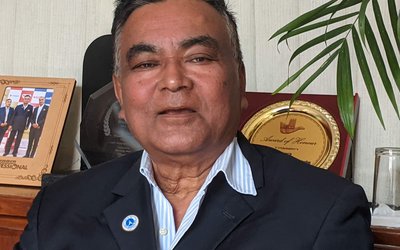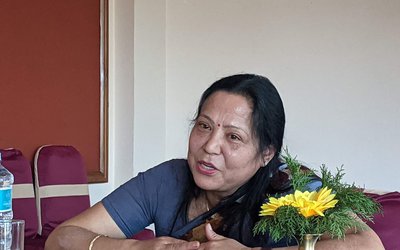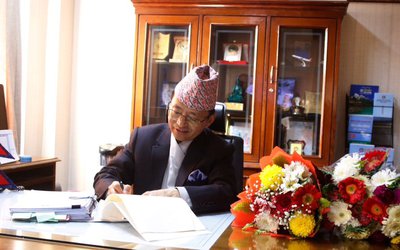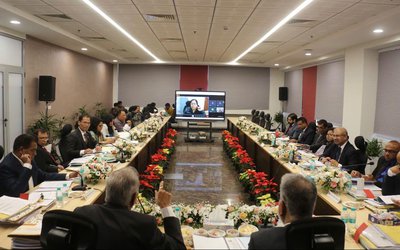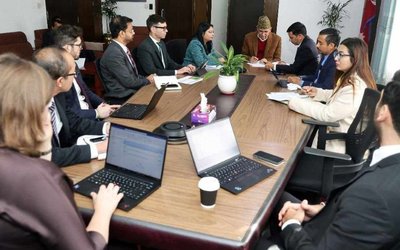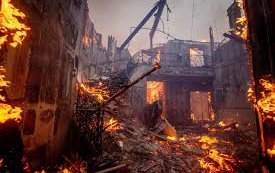
As we are close to the end of the year 2017, how do you see the possibility of making Nepal an Open Defection Free country?
Despite major floods, earthquakes and other natural disasters, Nepal has performed well towards becoming ODF. We cannot achieve sanitation for all this year, but we are close to achieving it. The last floods have badly affected our achievements. We covered 84 percent with our sanitation program in Rautahat, but the floods badly hurt the campaign. The situation is the same in 15 districts. Given the present pace, what I can say is that we will cover over 93.3 per cent. We are working hard to achieve it. We can achieve up to 98 percent sanitation.
How did the 2017 flood affect the campaign to provide toilets?
Although the reports of all flood affected districts are not available, from the preliminary estimates, it is found that a total of 26,499 toilets were fully and partially damaged in 15 Terai districts. The highest damage was in Morang (6,236) while the lowest was in Jhapa (20). Two ODF declared districts namely Bardia (6,137) and Dang (550) were hard hit by the floods and there was a high damage of toilets- 6,137 and 550 toilets respectively.
How did the restructuring of the local bodies affect the ODF campaign?
Although new restructuring drive has generated a small confusion, the drive has not disturbed our sanitation process. It has rather made it easier for use to work. There were many local bodies before the local restructuring. Now the number has come down. There were many municipalities and village development committees earlier. Now, as the numbers have gone down, we find it easier to work.
As the country is close to achieving ODF, experts are also raising questions about fecal management. How do you look at this?
It is a technical issue. We are now constructing two-pit toilets, one part with water and the other with fecal. Fecal management is not a problem in hill areas. However, this is a problem in terai where water table is high and frequent flood creates problems. In the initial phase, we built most of the toilets with a single pit because we had declared to achieve sanitation for all by 2017 with limited resources and time. With an aim to achieve the target, we ignored the fecal management issue in construction of toilets in the initial phase. However, now, we are incorporating the technical side for fecal management as well.
With less than a month for 2017 to end, how do you sum up the progress in ODF campaign?
As I told you we are very close to achieving the target. Had the floods not disrupted our work, Nepal would have been in a position to achieve the goal. Our sanitation coverage now is 93.7 percent. As Nepal is in the process of holding the elections, I cannot claim that Nepal will achieve 100 percent target soon, but we can achieve 98 percent. I think we are still close to our target.
There is low progress in Terai compared to other areas. Is it related to money?
All the eight districts of terai are high earners of remittance and there is enough money. Money has nothing to do with the low number of toilets. People are not building toilets because of their attitudes. Although poor people live in some places, it is the rich who don’t want to build the toilets. In many areas, people are unable to build the toilet because landowners do not allow tillers to do so. We are addressing it by building community toilets and public toilets.
How do you see the state of public toilets?
This is a real problem. This is not only in Terai but also a problem of urban areas like Kathmandu. There is the need to have public toilets and community toilets to achieve the universal sanitation coverage.
At a time when we are working to make 100 per cent sanitation coverage, how do you see the progress in hand-washing?
Hand washing is one of the important components of sanitation. Hand washing with soap alone can reduce 44 percent Diarrhea incidence. Sanitation (safe toilets) reduces 32 percent and PoU treatment of drinking water reduces 39 percent. Source water treatment reduces 11 percent. Hand washing with soap, combined with treated water and sanitation can stop the diarrhea nearly 100 percent. It controls the diathermia disease.
What are other contributions?
As I mentioned proper hand washing with soap can reduce diarrheal death of children under 5 by nearly 50 percent. According to a study, it saves globally 525000 deaths a year.
Hand washing can reduce nearly 50 percent ARI (acute respiratory infections) in children. It considerably reduces the intestinal worm infections. It considerably reduces the Skin and Eye infections. Hand washing is vaccination against many diseases.
What is the current situation in Nepal?
No authentic data base is available, but the situation is not very encouraging. Nepalese are habitual to wash hands with plain water. Hand washing with soap is increasing as a trend. Percentage of hand washing with proper hand washing facilities is quite low or merely 20 percent. However, eighty percent of schools are reported to have hand washing facilities. But, many schools have severe water shortage. It is a fact that hand washing facilities in public places are rare.
What are the initiatives taken so far?
Some initiatives have already been taken, like various programs have already been organized to make hand washing a habit. Focused programs to wash hands in critical times like Aghi tin, Pachhi tin (Three initially and later three) has already been introduced. Hand washing with soap is one of the major activities in Total Sanitation Campaign. Many Governments and Non Government institutions are working in hand washing campaigns.
How do you see the achievements?
So far as our achievement is concerned, there are 42 ODF Declared Districts, District with 100% coverage- 7, District with over 90 percent coverage 11, district with 80-90 percent coverage- 10 and District with over 80 percent coverage 5.
How do you see the state of sanitation in terms of new local levels?
Gaupalika 330 out of 460, 330 Gaupalika and out of 293 Municipality 164 have already been declared ODF. Toilet coverage has increased in all the provinces. Out of 7 provinces, No 4 and 6 provinces have 100 percent coverage. Out of 77 districts, 41 districts are declared ODF. Since 1990 till now, Nepal has made 94 percent success. In terms of provinces, No. 1 province has 97.5 percent, No. 2 province 78.5, No. 3 provinces 93, No. 4 province 100, No. 5 province 97.75, No. 6 province 100 and No. 7 province 99.85.
Which districts are most challenging?
Eight districts of No. 2 province are most challenging. The toilet coverage in the district includes: Parsa 80 percent, Rautahat 84.1 percent, Bara 65 percent, Sarlahi 70 percent, Saptari 87 percent, Siraha 87 percent, Dhanusha 77 percent and Mahottarai 75 percent.
- FM DR.RANA INDIA VISIT: Strengthening Relations
- Jan 02, 2025
- BUTWAL-HETAUDA Connected By 220 kV
- Jan 02, 2025
- PM OLI' CHINA VISIT: A Success For Business
- Jan 01, 2025
- ISRAELI AMBASSADOR SPEAKS: Israel For All Possible Support To Nepal
- Jan 01, 2025
- NEPAL-INDIA ENERGY TRDE: A Silver Lining For Nepal
- Dec 31, 2024




